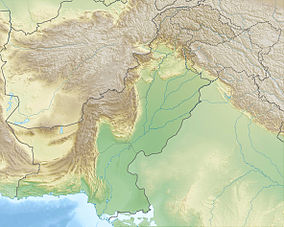Hingol National Park
| Hingol National Park ہنگول نیشنل پارک | |
|---|---|
 The park's dramatic landscapes are connected to nearby Karachi via the Makran Coastal Highway. | |
| Location | Lasbela, Baluchistan |
| Coordinates | 25°36′N 65°40′E / 25.600°N 65.667°E |
| Area | 6,100 square kilometres (2,400 sq mi) |
| Established | 1988 |
| Governing body | Wildlife and Parks Department of Government of Pakistan |
Hingol National Park or Hungol National Park (), covers an area of 6,100 square kilometres (2,400 sq mi). It was established in 1988. In 2004, the Makran Coastal Highway which links Karachi with the port town of Gwadar was opened.
Geography





Hingol National Park is along the Makran coast in southwestern Balochistan Province, southwestern Pakistan. It lies within sections of Lasbela District, Gwadar District, and Awaran District. The Gulf of Oman of the Arabian Sea are to the south.[1] The provincial capital of Quetta is approximately 717 km. The provincial capital of Sindh is 190 km to the southeast on the coast.
Hingol National Park also includes famous Kund Malir[2][circular reference] Beach and Princess of Hope.[3] In the past due to the political situation, people didn't prefer to go there. But now things have changed and many people go to Kund Malir on weekends from Karachi and other areas of Sindh to explore the beach.
Natural history
Flora
Hingol National Park contains a variety of topographical features and habitats, varying from arid subtropical forest in the north to arid montane in the west. Large areas of the park are covered with drift sand and can be classified as coastal semi desert. The park includes the estuary of the Hungol River which supports a significant diversity of bird and fish species.[4]
Some 250 plant species were recorded in the initial surveys including 7 yet undescribed species. Many more species are yet to be collected.[citation needed]
Fauna
Hingol National Park is known to support at least 35 species of mammals, 65 species of amphibians and reptiles, and 185 species of birds. The park forms an excellent habitat to wild Sindh ibex, Baluchistan urial, and chinkara gazelle. Ibex is found in all steep mountain ranges and are numerous in the Hinglaj and Rodani Kacho Mountain areas. The population is estimated over 3000.[5]
Mammals
- Sindh leopard
- Indian fox
- Jungle cat
- Pakistan sand cat
- Striped hyena
- Golden jackal
- Sindh ibex
- Urial
- Chinkara
- Honey badger
- Indian pangolin
- long-eared hedgehog
- Indian crested porcupine
- Indian gray mongoose
- Cairo spiny mouse
Reptiles
- Marsh crocodile
- Olive ridley
- Green sea turtle
- Desert monitor
- Yellow monitor
- Indian fringe-fingered lizard
- Indian sand-swimmer
- Carrot-tail viper gecko and the Melanophidium bilineatum
Birds
- Houbara bustard
- Spot-billed pelican
- Dalmatian pelican
- Bonelli's eagle
- Imperial eagle
- Golden eagle
- Tawny eagle
- Griffon vulture
- Egyptian vulture
- Cinereous vulture
- Laggar falcon
- Red-necked falcon
- Kestrel
- Brown-necked raven
- Lichtenstein's sandgrouse
- Grey partridge
- See-see partridge
- Stone-curlew
- Indian sandgrouse
- Crowned sandgrouse
- Painted sandgrouse
- Eurasian stone-curlew
- Eagle owl
- Sind pied woodpecker
- Hume's chat
- Long-billed pipit
- Striped bunting
- Finch-larks
- Hoopoe
- Shrike
- Black bittern
- Goliath heron
- Black ibis
- Wheatear
Amphibians
Fish
- Golden mahasheer
- Botchee
Non-Living attractions
- Princess of hope
- The Balochistan sphinx
Conservation
There are 14 species of birds of special conservation interest on account of being threatened (as per IUCN Red List 2005), very rare or key species of the park.[6]
- Sociable lapwing (critically endangered)
- Saker falcon (endangered))
- White-backed vulture (vulnerable)
- Spot-billed pelican (vulnerable)
- Dalmatian pelican (vulnerable)
- Eastern imperial eagle (vulnerable)
- Pallas's fish eagle (vulnerable)
- Houbara bustard (vulnerable)
- Black ibis (near-threatened)
- Black-tailed godwit(near-threatened)
- Sooty falcon (rare)
- Goliath heron (vagrant)
- Desert owl (confined to Makran Coast only)
- Brown fish owl (very rare)
Management
According to independent reports, 20 staff members, 18 game watchers and 2 deputy rangers are responsible for the management of the park. They are under the guidance of the park manager, who reports to the conservator and the Secretary of Wildlife, Forest, Livestock, Environment and Tourism.[citation needed]
See also
References
- ^ Wildlife of Pakistan - Hingol National Park
- ^ Kund Malir
- ^ https://www.dawn.com/news/1169526
- ^ "Country Report on Plant Genetic Resources for Food and Agriculture – Pakistan" (PDF). parc.gov.pk. Pakistan Agricultural Research Council. Archived from the original (PDF) on January 18, 2012. Retrieved September 8, 2010.
- ^ "Hingol National Park". Pakistan Paedia: National Parks. JalalsPages. 12 September 2006. Retrieved 2008-10-15.
- ^ Syed Ali Ghalib, Abdul Jabbar, Jan Wind, Afsheen Zehra, Darakhsan Abbas. (2008), Avifauna of Hingol National Park, Balochistan, Pakistan J. Zool, pp. 317-330

